Ewart Oakeshott: The Man and his Legacy: Part V
An article by Chad Arnow,
Russ Ellis,
Patrick Kelly,
Nathan Robinson, and
Sean A. Flynt
Compiled and produced by Nathan Robinson
Page 5 of 5 — Go to: Prev 1 2 3 4 5
We come finally to Oakeshott's concept of sword families, his least-known categorization but perhaps the most important of them all. Oakeshott presents the concept of families in the introduction of his Records of the Medieval Sword. The entire section is often skipped as readers jump straight to the photos (the "records") of medieval swords.
The previous typology classes seek to break the sword apart into its main components: blade, pommel, and guard. When taking the parts individually, however, it can be difficult to fully understand the sword's origin.
The concept of families takes the sword as a whole. Oakeshott tells us that "by the end of the 13th century and onward into the 16th more and more swords fall into what I would call 'families' which tend to cut across the types, and are pretty obviously the result of recognisable trends in fashion." These families often give more clues for date and region of origin than do the separate components. Since they encompass the blade types, they also make common threads easier to see without getting too caught up in the individual details. The identification of the individual parts is just the beginning of a sword's classification, not the end.
Oakeshott chose to illustrate only the major families in Records of the Medieval Sword. Indeed, many other families exist, as do many examples that do not quite fit a particular family. As with all his categorizations, this should be seen as "merely a scaffolding to bring some order into the otherwise amorphous and infinitely varied mass of medieval blade, cross, and pommel forms."
Family A |
Family B |
Family C |
Family D |
Family E |
Family F |
Family G |
Family H |
Family I |
Family J |
Family K |
Family L |
Family M
| Family A |
Family B |
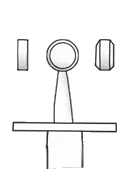
This short hilt has a disc or wheel pommel and a straight cross, often thick and of square cross-section. This family of swords saw use between circa 950-1550, but was most popular circa 1050-1300.
View Example, circa 1100-25
|
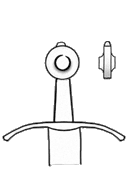
Another short hilt, this one has a very wide and flat wheel pommel with a pronounced central boss. The cross-guard is of thin cross-section, sloping downward, and has plain ends. Most swords of this family are of Type XIV and can be dated to the rather short period of use of circa 1280-1325.
View Example, circa 1270-1320
|
|
| Family C |
Family D |

This family includes nearly all of the swords of Type XIIIa. This family extends from circa 1100 to 1360, with many examples present in artwork after circa 1250. The hilt is long with a thick wheel pommel and straight cross-guard.
View Example, circa 1350
|
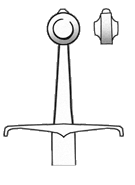
Following Family C, this example was popular between circa 1360-1410. The hilt is long and has a thick wheel pommel. Unlike Family C, Family D pommels often have recessed central bosses. Another defining feature is the long, straight, rhomboidal (or round) cross-guard. Well-defined examples have a swelling in the cross's center, creating an ecusson. The tips of the cross turn at an acute angle and point towards the blade tip.
View Examples, circa 1370
|
|
| Family E |
Family F |

One of the defining features of this family is the wedge-shaped pommel with hollow "scalloped" shapes on its upper arched surface. The cross is long and is a thin square-sectioned shape with no swelling at its midpoint. Its ends arch towards the tip of the blade. Swords of this family are often called the "Sempach" type, referring to two notable examples belonging to knights who fought at the battle of Sempach near Zurich in 1386.
View Example, circa 1370-1400
|

Oakeshott refers to swords of this family as the "epitome of the medieval sword," noting that it defines the archetype of the knightly sword's form. The popularity of this sword spans from circa 1410 through perhaps 1550. The short hilt is accompanied by a long down-sloping cross of complex cross-section with a well-defined ecussion at its center point.
View Examples, circa 1420-50
|
|
| Family G |
Family H |

The short hilt on this family of swords has a heavy wheel pommel and a shortened version of the cross found in Family D. Artwork of circa 1380-1440 shows examples of this family well.
View Examples, circa 1420-50
|
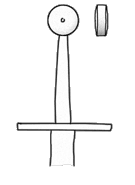
Oakeshott refers to swords of this family as "dull, lifeless, and undistinguished," noting the unsophisticated nature of its design. The pommel is a flat disc with little detail and the cross is a long, "shapeless bar of metal of round or square section." It is hard to date these examples, as there are not many survivors despite at least one being found in most major collections.
View Example, circa 1380-1420
|
|
| Family I |
Family J |
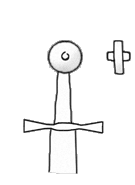
Many examples of this family survive in the arsenals of Alexandria and Constantinople, leading us to presume a South European origin. The pommels are almost always of bronze and in the form of a large flat disc with pronounced central bosses. The crosses are narrow and shaped like bow-ties with flat cross-sections. The wide blades, have nearly parallel edges, rounded tips, and narrow fullers running two-thirds their length.
View Example, circa 1350-60
|

Most surviving swords of this family are from the Castillon find and are seen in art dating circa 1420-1470. They are defined by their rather long fish-tail pommels and rounded crosses. A noticeable swelling is found at the cross's center and its ends are finished with rounded knobs. The grips are short, but the long pommel helps offset this fact.
View Example, circa 1440-60
|
|
| Family K |
Family L |

Having a hilt generally of hand-and-a-half proportions, these Danish swords are equipped with a flat wheel-shaped pommel with central bosses on each face. The crosses are of a bow-tie shape. Few surviving examples are known.
View Examples, circa 1300-25
|
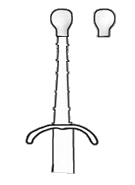
Another Danish variant, this extremely long-gripped war sword of the late 15th century features a pear-shaped pommel and a short cross generally of a flattened section and arching towards the blade's tip.
View Examples, circa 1450-60
|
|
| Family M |
|
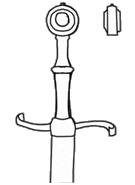
These swords were most common in Northern Europe during the later 15th and early 16th centuries. They have a long two-part grip, narrow below the pommel, swelling at the center, and again becoming narrow at the cross. The pommels are of a disc shape with recessed circular bosses at the center. The crosses are generally quite long and are often S-curved at a right angle to the plane of the blade.
View Example, circa 1450-80
|
|
|
Conclusion
Ewart Oakeshott's passion for the medieval sword, his careful study of it, and his many publications have made these weapons much more accessible and understandable to the scholars, collectors, re-enactors, and hobbyists. He has also done much damage to the old myths and wives tales about sword weights, showing that they were much more elegant and complex weapons than the crude sharpened cudgels they have been made out to be.
Thanks to increasing interest in swords, the number of people affected by Oakeshott's work continues to grow. They are martial artists looking to rediscover the "olde" ways, scholars attempting to date new archeological finds, collectors looking for accurate information, or people inspired by the recent abundance of movies involving sword-wielding characters. One of Oakeshott's hopes was that his work would not be the end of a learning process for sword lovers like himself, but a doorway to new discoveries; Even Oakeshott, learned as he was, referred to himself as an "amateur". "It will fall then, maybe to you who read this," he wrote in Records of the Medieval Sword, "to take over where I have to leave off."
Sources
Archaeology of Weapons: Arms and Armour from Prehistory to the Age of Chivalry, The, by R. Ewart Oakeshott
Sword in the Age of Chivalry, The, by R. Ewart Oakeshott
Records of the Medieval Sword, by R. Ewart Oakeshott
European Weapons and Armour: From the Renaissance to the Industrial Revolution, by R. Ewart Oakeshott
Sword in Hand: A History of the Medieval Sword, by R. Ewart Oakeshott
Acknowledgements
Most of the accompanying text written by Chad Arnow
Typology in Detail table data and the pommel/cross descriptions supplied by Russ Ellis
Typology illustration created by Nathan Robinson and based on the work of Ewart Oakeshott
Sword line drawings created by Nathan Robinson, based on swords from Records of the Medieval Sword
Pommel, cross, grip, and sword family line drawings created by Nathan Robinson, based on the work of Ewart Oakeshott
List of published works created by Patrick Kelly
Contributions and fact checking provided by Craig Johnson of The Oakeshott Institute
Editing tasks provided by Nathan Robinson, Chad Arnow, and Sean Flynt
Production services provided by Nathan Robinson
Additional Information
Please see our Spotlight Articles on each Oakeshott sword type:
Type X, Type XI, Type XII, Type XIII, Type XIV, Type XV, Type XVI, Type XVII, Type XVIII, Type XIX, Type XX, Type XXI and XXII
|
|

